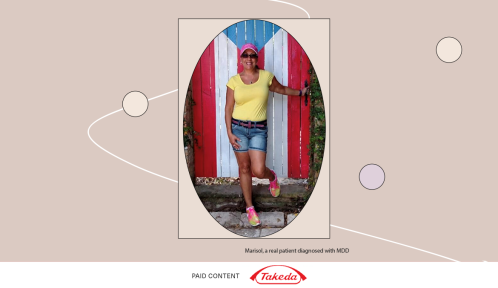Ketamine Is Straddling the Worlds of Wellness and Science To Go Mainstream
Both the medical and wellness worlds are embracing ketamine, which is making ketamine wellness more popular than ever.

On a recent Tuesday evening, I arrived at a candlelit, sage-filled yoga studio in Venice, California, feeling nervous, but excited. A greeter with a soft, soothing voice asked me if I would “be taking the medicine on my journey.” Yes, yes I would: I was here to try ketamine for the first time, as part of a group “keditation”—a ketamine meditation.
Experts in This Article
Medical Director of Nushama Psychedelic Wellness Center
Physician Assistant and Wondermed Lead Clinician
Founder of rehab facility All Points North and wellness facility 9x.
Post-Doctoral Fellow in Clinical Psychology, Founder of the Ketamine Research Institute (KRIYA).
Licensed Marriage and Family Therapist and ketamine therapy practitioner.
Instagram had been serving me ads for in-clinic ketamine treatments for months and I was intrigued by the concept of taking a “trip” as a way to work on my mental health. So a month earlier, I had attended a launch party for a company called Wondermed. The event inspired me to sign up for the company’s at-home ketamine protocol, which is intended to treat anxiety and depression. So after a 40-minute interview with a physician assistant, I received four ketamine lozenges, plus a blood pressure monitor, journal, eye mask, and ginger supplements in the mail.
But the lozenges just sat in a drawer. I was too apprehensive to take one on my own—until that Tuesday, when I packed up my journal and a lozenge, and headed to Wondermed’s keditation.
At the yoga studio, attendants showed me to a room filled with a couple dozen inflated mats covered with patterns of the universe. There were blankets, eye masks, headphones, and pillows on every mat. I chose one right in the middle.
As people filtered in, we were instructed to journal our intentions for the trip. I thought about how I didn’t want to feel scared of inhabiting any corners of my mind, and wrote that I wanted to teach myself that my mind was a place I actually liked to be. Then, with our eye masks and headphones in place, the company’s head of patient experience started a 10-minute guided meditation while we allowed the lozenge to dissolve in our cheek.
And the trip began.
A DJ wearing a ruffled shirt took over, switching up the instrumental music every two minutes so our sonic environments would constantly change. I was nervous that I hadn’t allowed the lozenge to dissolve correctly—you’re not supposed to swallow at all during the 10-minute dissolving period—but then my hands started feeling pleasantly molten. Soon, I was swooping through underwater scenes, I was a cat licking the plate of life, I saw my family surrounding me in the shape of a ribbon holding me up and supporting me. I was able to examine the anxiety I was feeling and figure out where it was coming from, and what it said about me as a person—that I just wanted to get the most out of every experience.
I was able to examine the anxiety I was feeling and figure out where it was coming from, and what it said about me as a person.
Once the trip wound down after an hour, we were instructed to remove our headphones and write anything that occurred to us. Then we spoke with a partner about our experiences, and I was surprised by how freely I was able to create a narrative of the trip. As I was chatting with my partner, I felt the floor become less wobbly, my body go from loopy and floaty to solid once more.
I had done a ketamine meditation, and I’d loved it.
Ketamine therapy is a legal medical treatment
I was able to take ketamine out in the open of a yoga studio thanks to the mainstreaming of the substance as a mental health treatment. Ketamine is a legal drug that doctors can prescribe as an anesthetic. But it is also considered a psychedelic, and can be prescribed for off-label use as a treatment for depression or anxiety. Off-label prescriptions like this are a common practice: It’s how people get prescriptions for Botox to treat migraines, when Botox’s primary, FDA-approved use is as a wrinkle reducer. However, a “consensus statement,” or an agreement by doctors on the best practices of the treatment, “strongly cautions against the practice of take-home, self-administration of ketamine,” says an article published in Journal of the American Medical Association on the topic.
A synthesized amino compound engineered by scientists, ketamine blocks the activity of certain neurotransmitter receptors in the brain, which is thought to be the mechanism by which it treats depression. Studies in mice have found that it stimulates the production of new synapses in areas of the brain that have been hampered by stress.
A growing body of research published over the last 20 years by the likes of Yale University, Nature, and other members of the scientific and medical communities have shown that ketamine is an effective treatment for post-traumatic stress disorder (PTSD), anxiety, and depression, and particularly treatment-resistant depression (TRD). In 2019, the FDA even approved a ketamine variant called esketamine for treating TRD in clinical settings.
Today, there are multiple ketamine treatment companies (like Wondermed), psychiatric clinics that administer ketamine therapy, and even ketamine infusion centers that dispense the drug without therapy. “I would say ketamine therapy is already mainstream,” says Sara Reed, MS, LMFT, a ketamine therapy practitioner based in Kentucky who has seen clinics pop up throughout her state.
Multiple ketamine practitioners I spoke to described the medical world as “curious” about ketamine. They say the research is so promising that it cannot be ignored, though studies are ongoing.
“They’re seeing that it has amazing potential,” says Steven Radowitz, MD, the medical director of Nushama Psychedelic Wellness Center. “More and more doctors and psychiatrists are definitely getting on board because they’re seeing the studies.”
The wellness world is embracing ketamine, too
Because of its legal status, ketamine occupies a unique position in the psychiatric medical space. That is, it is not just limited to the clinical trials and studies undertaken by the medical community for treating serious illnesses like PTSD and TRD. It is also being marketed as a wellness treatment.
When I first got to know Wondermed at the company’s launch party, I was struck by how the scientific treatment was presented at an event that can only be described as woo-woo: It offered IV supplement infusions, ashwagandha sprays, superfood pancakes, and a 45-minute breathwork session. The setting and experience of the keditation itself—with its cosmic mats, burning palo santo, and New Age tunes—also felt like one of the more “wellness”-y things I’ve ever done.
Wondermed’s ketamine therapy option is not usually a keditation: Most patients take ketamine on their own, following a pre-recorded guided meditation and playlist. Reed sees this type of therapy as potentially beneficial for some people, but not necessarily at the same level as treatment that someone would get in a clinic where they’re supervised by a clinician and process the experience with a mental health professional.
A solo trip “might only be suitable for some folks who are looking to explore their own consciousness, but it’s not a fit for everyone,” Reed says.
Ketamine is also on offer at wellness centers, like at 9x in Malibu, where it is a treatment option alongside fitness classes, deep transcranial magnetic stimulation, and massage. “I like to say that we’re a physical, mental, and spiritual health provider, because it’s all integrated,” says Noah Nordheimer, the founder of APN, the company behind 9x.
On Instagram, ketamine is advertised by brands like MindBloom and Field Trip Health. Field Trip’s website entices viewers to “experience yourself in a new way,” a decidedly broader and more wellness-oriented positioning than a way to treat TRD.

Wondermed’s lead clinician, physician assistant Lauren Swanson, says combining wellness practices with ketamine is intentional. “Ketamine has its properties in the brain and its biochemistry,” Swanson says. “But what research has found is that if you couple that with the holistic offerings, such as meditation and breathwork, going into the session with preparation and an intention and trying to integrate that into your life, you’re going to get so much more out of the ketamine.” Reed and Radowitz agree that integration—or talking through and processing the experience—is key to the treatment’s efficacy.
Straddling the worlds of wellness and science
The wellness industry often gets a bad rap because of its pseudoscientific tendencies. And not everyone is thrilled that ketamine is expanding to areas that don’t involve the direct supervision of a medical professional.
“This kind of work can only truly be done by a trained psychotherapist embedded within the context of regular talk therapy sessions,” ketamine therapy practitioner Raquel Bennett, PsyD, wrote in a 2019 issue of the MAPS Bulletin. “Any other kind of provider in any other context is offering pseudo-therapy.”
Radowitz agrees that ketamine therapies need to be practiced with “integrity,” and must come with sound therapeutic protocols. But he also sees that ketamine might actually be a bridge between wellness and science in a way that benefits patients.
“Having a purely mechanistic or medicinal approach to mental health hasn’t really worked out for us,” Radowitz says. “The way I see psychedelics is a very good and beautiful sort of a place where the two worlds really blend well.”
Swanson says that some of Wondermed’s more wellness-oriented prospective patients have been skeptical of ketamine treatment, because it’s a synthesized—not natural—medicine. But because it’s a treatment you take only once or a handful of times, and because it’s integrated with practices like setting an intention, ketamine treatments could be seen as an olive branch from the medical world for the wellness community.
“I do think it really opens up eyes and hopefully also trust in the medical community,” Swanson says. “It really does help to bring trust for those patients because they feel like, okay, we are following a whole mind-body-spirit approach.”
Swanson is hopeful that the medical world would not “look down on” ketamine treatment because it incorporates holistic practices, while Radowitz stresses that ketamine treatment should not be marketed as a mental health panacea, and must be “approached with caution.” But this drug is proliferating in hospitals and yoga studios alike. And if it can be a bridge between wellness and science, spirituality and mental health, hopefully it will be one people walk across with their eyes wide open to both its limitations and potential.










